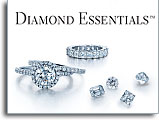Diamonds can captivate,
spellbind and express emotions that cannot otherwise be put into words. Whether
it is the ramp walks of the fashion capitals of the world, or somewhere more
intimate, like a one-on-one proposal after a home cooked meal, a diamond is
equally at home in any setting. A must-have for your beloved, a great
investment and a status symbol for those who want to display their wealth and
status, diamonds fit many roles and many needs, with equal aplomb.
From the 2nd century B.C Rome,
when they were first put into rings and other ornaments to embellish them and
create statements of perfection, diamonds have been cut into various shapes, to
both enhance their appeal, and to make them suitable for use in various pieces of jewelry.
In this part of our series of
the world’s favorite shapes in diamonds, we will take a closer look at Cushion
cut, Emerald Cut and Radiant Cut Diamonds. We will examine their distinct
features, explore their differences and discover the kinds of jewelry they fit
best into. So without further ado, let us begin our exploration…
Cushion
Cut Diamonds:
Cushion cut diamonds, often
referred to as ‘old mine cut’ diamonds, combine a square cut with rounded
corners. This gives the finished diamond the appearance of a cushion or pillow,
lending to its name. These diamonds are amongst one of the oldest cut of
diamonds still in use, with their history dating back nearly two centuries. So
popular were they, that until the opening decades of the 20th century they were
often the de-facto cut of diamonds, which simply meant that compared to other
shapes, they were the preferred shape/style of a diamond.
While other shaped diamonds
like Asscher, Oval and Marquise have been significantly popular in the 20th
century, steady research in improving the grade and standards of Cushion Cut
diamonds, see their resurgence today.
Based on research by Marcel Tolkowsky in the 1920's,
refinements to cushion cut diamonds over time (such as shrinking the culet,
enlarging the table, and improving cut angles for increased brilliance), have
led to resurgence in popularity. Many buyers are attracted to the antique feel
combined with modern performance offered by the cushion cut.
Perfect for both solitaire pendants and chunky engagement rings, Cushion
Cut diamonds lend an old-world charm and nostalgic flair to any piece that you
may pick out.
Emerald Cut Diamonds:
An elegant if somewhat offbeat cut of diamond is the Emerald Cut. The
unique look of the Emerald Cut diamond is created by the step cuts of its
pavilion and its large, open table. Instead of the sparkle of a brilliant-cut,
emerald cut diamonds produce a hall-of-mirrors effect, with the interplay of
light and dark planes.
 |
| Emerald Cut Diamond |
While the individual ‘fire’ and brilliance of an Emerald Cut diamond isn’t
comparable to any of the other cut of diamonds, the long lines and dramatic
flashes of light give the emerald cut an elegant appeal. The shape was
originally developed for the cutting of emeralds, thus the name. Emeralds cut
diamonds vary from nearly square to a narrow rectangle. The classic emerald cut
diamond has a length to width ratio of around 1.50.
Wildly popular for making pendants and rings for men, the Emerald Cut is
a unique and beautiful, albeit dramatic and not for everyone option, when considering
buying a diamond for your loved one!
Radiant Cut Diamonds:
The radiant cut diamond is the first square cut (the second being the
princess) to have a complete brilliant-cut facet pattern applied to both the
crown and pavilion, creating a vibrant and lively square diamond. Form factor
aside, this type of diamond, has a radiance which is unique to square cut
diamonds!
 |
| Radiant Cut Diamond |
First popular in the 1980's, the cropped corner square shape of the
radiant is a nice bridge between a cushion and a princess cut, and for that
reason looks beautiful set with both rounded or square cornered diamonds.








Nice read! I like the suggestions.
ReplyDeleteAll shapes are good but emerald cut Diamond is attracting the most... Brilliant info on different diamond cuts and their shapes
ReplyDelete